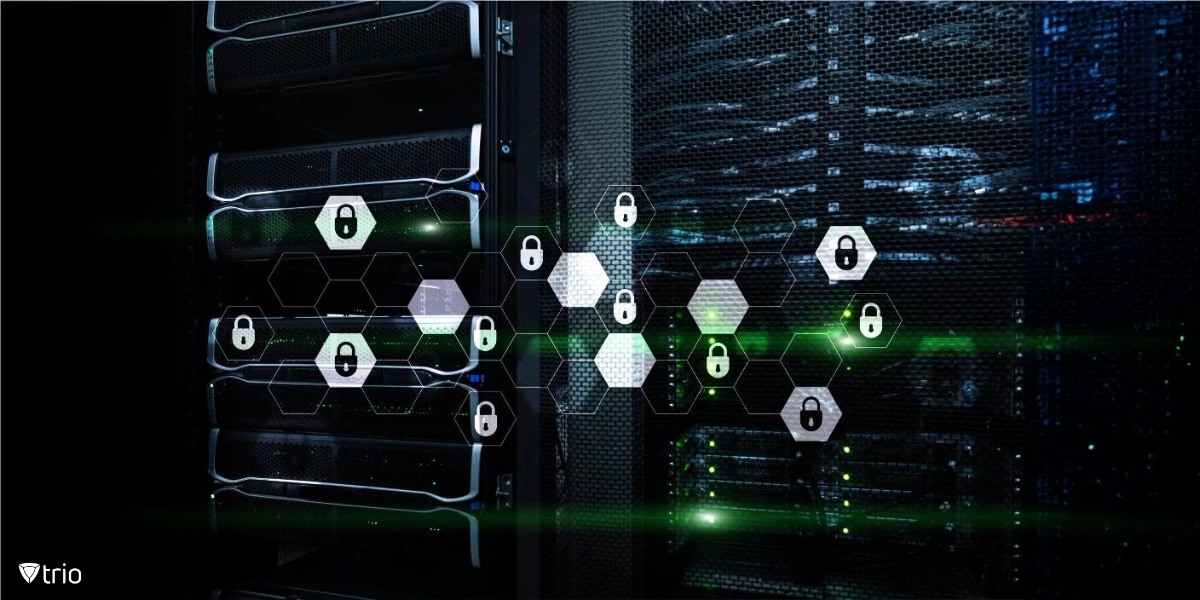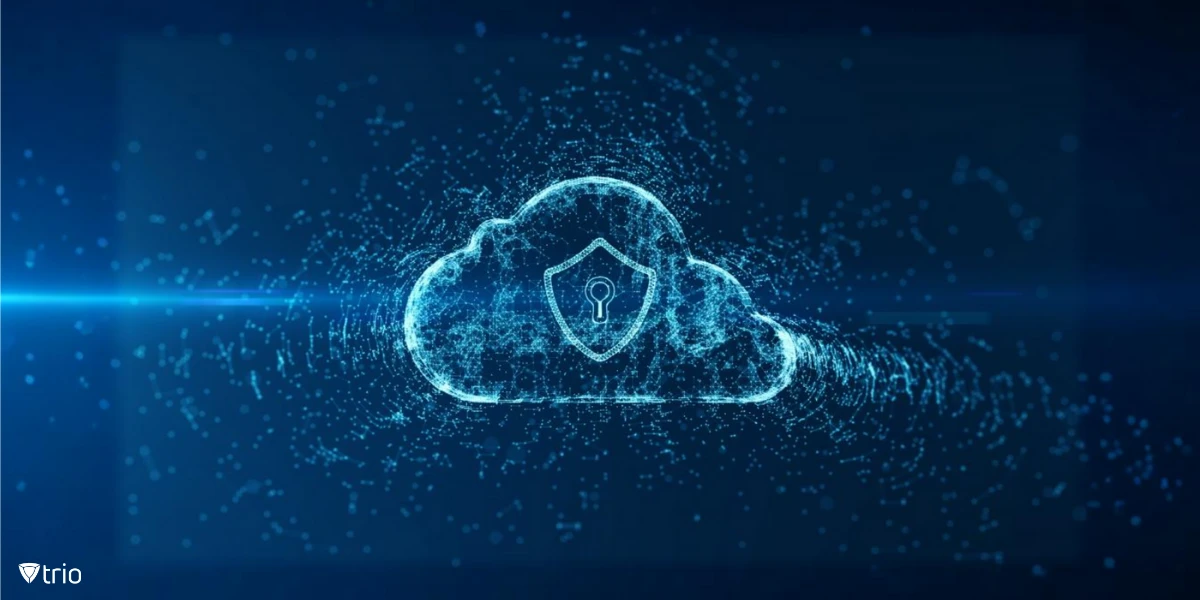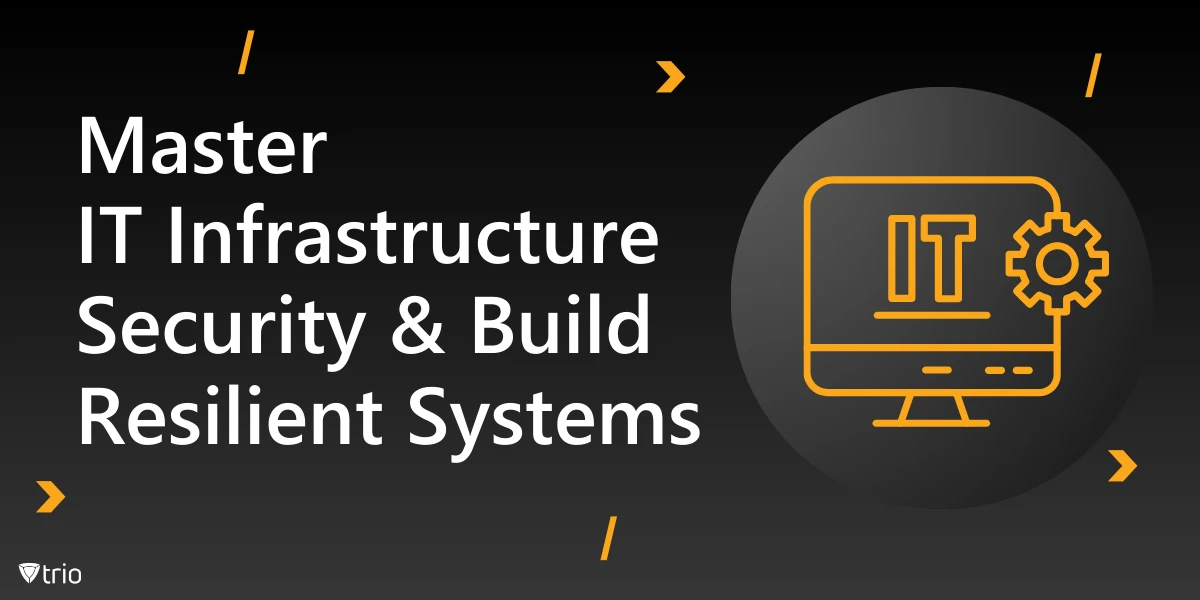As businesses navigate the complexities of the digital age, securing IT infrastructure has emerged as a critical cornerstone of operational success. It encompasses the processes, tools, and strategies designed to protect critical systems and data from cyber threats. With the increasing reliance on cloud infrastructures, remote work environments, and data-driven operations, securing IT infrastructure is no longer optional – it’s a necessity.
To appreciate its importance, consider this: IT infrastructure serves as the backbone of an organization’s network, housing everything from servers and operating systems to data centers and cloud services. As cyber threats grow in complexity, so does the need for robust security measures. This blog will explore security infrastructure examples, essential tools, strategies to build a secure IT infrastructure, and how Trio’s simplified MDM solution can enhance your defenses. Along the way, we’ll touch on related topics like IT asset management strategy and IT support to provide a comprehensive view of this critical field.
What Is IT Infrastructure Security? A Definition of Critical Infrastructure
IT infrastructure security refers to the measures and practices implemented to safeguard an organization’s critical infrastructure. This includes physical hardware, software, networking components, and cloud infrastructures. The goal? To mitigate security risks, protect sensitive data, and ensure uninterrupted business operations.
Critical infrastructure involves essential systems that, if compromised, could disrupt business continuity. Examples include data centers, network security appliances, and cloud service providers. When defining critical infrastructure, organizations must consider their unique operational needs, regulatory requirements, and potential threats.
Why Is It Important?
- Prevention of Data Breaches: Breaches are costly in both financial and reputational terms. Strong security measures protect sensitive information.
- Continuity of Business Operations: Secure IT infrastructures minimize downtime caused by cyberattacks or system failures.
- Compliance with Regulations: Many industries have strict data protection laws requiring robust infrastructure security protocols.
For businesses aiming to streamline their operations, integrating IT process automation into their infrastructure can enhance efficiency while maintaining security standards.

Security Infrastructure Examples and Tools to Protect Your Systems
Effective IT infrastructure security relies on a blend of technologies, processes, and human oversight. Here are some security infrastructure examples and tools that every organization should consider:
Essential Security Infrastructure Tools
- Intrusion Detection Systems (IDS): These tools monitor network traffic to detect suspicious activity, enabling swift responses to security issues.
- Multi-Factor Authentication (MFA): By adding layers of verification, MFA reduces unauthorized access risks.
- Firewalls: Firewalls act as the first line of defense, filtering network traffic and blocking potential threats.
- Endpoint Protection: Safeguarding individual devices such as laptops and mobile phones from malware and other threats.
- Continuous Monitoring Solutions: Real-time monitoring tools ensure potential vulnerabilities are identified and addressed promptly.
Real-World Examples
- Data Center Security: Physical and digital security measures, such as biometric authentication and encrypted data storage, protect critical assets.
- Cloud Infrastructures: Services like AWS and Azure provide built-in security tools, such as identity access management and encryption.
- Network Security Appliances: These include routers and switches configured with advanced security protocols to safeguard communications.
To further enhance security, organizations can adopt strategies outlined in IT collaboration frameworks, ensuring teams work cohesively to address threats.
How to Build a Secure IT Infrastructure: Best Practices for Success
Creating a secure IT infrastructure involves a combination of strategic planning, robust tools, and a proactive security strategy. Below are actionable steps to achieve this:
Step 1: Conduct a Comprehensive Risk Assessment
Begin by identifying potential threats and vulnerabilities. A detailed risk assessment provides a foundation for prioritizing security measures.
- Identify Critical Assets: Determine which systems and data are most valuable to your organization.
- Evaluate Threat Scenarios: From insider threats to external attacks, consider the full range of possibilities.
Step 2: Implement Layered Security Measures
Layered security ensures multiple defenses are in place, making it harder for attackers to penetrate your systems.
- Deploy Intrusion Detection Systems: Monitor for unusual activity.
- Enable Multi-Factor Authentication: Add an extra layer of access control.
- Enforce Security Protocols: Regularly update operating systems, software, and hardware to patch vulnerabilities.
Step 3: Train Your Security Teams
Even the most advanced infrastructure security tools require skilled personnel to manage them. Regular training ensures your teams stay updated on emerging threats and solutions.
To complement these practices, consider integrating insights from IT infrastructure strategies to create a more cohesive security roadmap.
Proactively Managing Security Risks in a Cloud-First World
With the growing adoption of cloud infrastructures, managing security risks has taken on new dimensions. While cloud service providers offer built-in tools, businesses must also take responsibility for securing their data.
Cloud-Specific Security Measures
- Secure Access Management: Use role-based permissions and MFA to control access to cloud resources.
- Encrypt Data: Protect data in transit and at rest to prevent unauthorized access.
- Monitor Network Traffic: Ensure continuous monitoring of cloud environments to detect anomalies.
Addressing Common Security Issues
Despite strong strategies, cloud infrastructures are not immune to security risks. Some common issues include:
- Misconfigured Resources: Ensure proper configuration of storage, permissions, and firewalls.
- Shadow IT: Unauthorized use of cloud services can create vulnerabilities.
- Lack of Incident Response Plans: Prepare for worst-case scenarios to minimize damage during attacks.
Understanding common IT problems and their potential impact on security can further aid in addressing vulnerabilities effectively.

How Trio Can Enhance IT Infrastructure Security
Trio’s Mobile Device Management (MDM) solution is a powerful tool for securing IT infrastructure. Designed to address the challenges of modern security threats, Trio provides comprehensive protection for diverse business operations.
Key Features of Trio’s MDM Solution
- Centralized Device Management: Manage and secure all endpoints, including Android devices, Windows computers, and iOS devices, from a single platform.
- Real-Time Monitoring: Detect and respond to security risks as they arise with continuous monitoring capabilities.
- Enforce Security Protocols: Automatically deploy security updates and policies across all devices.
- Session Recording and Analysis: Gain insights into user activity for compliance and auditing purposes.
- Scalability for Business Growth: Trio adapts to the needs of small businesses and large enterprises alike.
A Free Demo Awaits You
Want to see how Trio can transform your security strategy? Ready to take your security to the next level? Explore how Trio’s MDM solution can help you build a secure IT infrastructure. Contact us for a free demo today and start protecting your defenses.
See Trio in Action: Get Your Free Trial Now!
Conclusion: Strengthen Your IT Infrastructure Security Today
In today’s digital world, IT infrastructure security is a foundation of business resilience. By understanding critical infrastructure, leveraging essential tools, and adopting a proactive security strategy, organizations can protect themselves from cyber threats and data breaches. Whether you’re managing on-premises systems or cloud infrastructures, continuous vigilance is key to safeguarding your operations.




